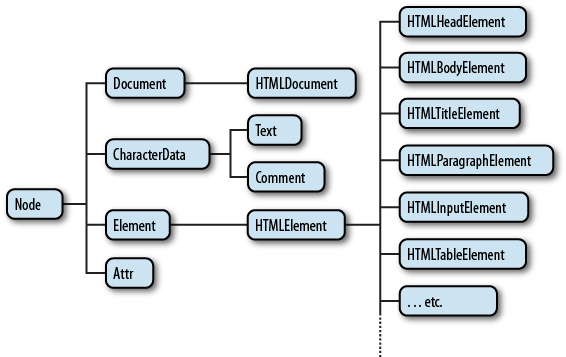| 일 | 월 | 화 | 수 | 목 | 금 | 토 |
|---|---|---|---|---|---|---|
| 1 | 2 | 3 | 4 | 5 | 6 | |
| 7 | 8 | 9 | 10 | 11 | 12 | 13 |
| 14 | 15 | 16 | 17 | 18 | 19 | 20 |
| 21 | 22 | 23 | 24 | 25 | 26 | 27 |
| 28 | 29 | 30 | 31 |
- 자바스크립트
- HtmlElement
- 노드 삭제
- HTML
- element
- jsp내장객체
- 이벤트
- 문자열
- Web
- 파이썬 코테
- addEventListener
- innerHTML
- 노드 객체
- 코딩테스트
- debugging
- Object
- Servlet
- 자바스크립트 이벤트
- 노드
- 리다이렉트
- 포워드
- HTTP
- webprogramming
- 노드 추가
- 이벤트 핸들러
- eventlistener
- Array
- 노드 replace
- backend
- javascript
- Today
- Total
seoyoung.dev
[javascript]-DOM Tree/HTMLElement와HTMLCollection 본문
자바스크립트 시리즈는 '생활코딩-클라이언트 과목의 '웹브라우저 자바스크립트' 강의'를 참고로
공부하고 기록하기 위한 용도입니다.
-> DOM (document object model) 은 웹페이지를 자바스크립트로 제어하기 위한 객체모델을 의미한다.
window 객체의 document 프로퍼티를 통해 사용할 수 있으며, 앞서 익힌 window 객체가 '창'을 의미한다면, document 객체는 윈도우에 로드된 '문서'를 의미한다.
-> 문서를 자바스크립트로 제어하려면, 제어의 대상에 해당되는 객체를 제일 먼저 찾아야 한다.
* getElementsByTagName()
<ul>
<li> html</li>
<li>css</li>
<li>JAVASCRIPT</li>
</ul>
<ol>
<li> html</li>
<li>css</li>
<li>JAVASCRIPT</li>
</ol> <script>
var ul = document.getElementsByTagName('ul')[0];
var lis = ul.getElementsByTagName('li');
//li 태그를 가진 요소들을 담은 유사 배열
//ul 태그 하위의 li 태그들만 조회
for(var i=0;i<lis.length;i++){
lis[i].style.color ='red';
}
</script>
* getElementsByClassName() 과 getElementById()
<ul>
<li>HTML</li>
<li class="active">CSS</li>
<li class="active">JAVASCRIPT</li>
<li id="act"> getById</li>
</ul> <script>
var lis = document.getElementsByClassName('active');
//유사 배열 lis (getElments 이니까 )
for(var i=0;i<lis.length;i++){
lis[i].style.color='red';
}
var li=document.getElementById('act');
//문서에서 id는 특정한 element하나만을 식별하는 식별자이므로 조회결과는 반드시 한 개
li.style.color="blue";
</script>
* querySelector() 과 querySelectorAll()
<ul>
<li> html</li>
<li>css</li>
<li>JAVASCRIPT</li>
</ul>
<ol>
<li>HTML</li>
<li class="active">CSS</li>
<li>JavaScript</li>
</ol> var li=document.querySelector('li');
//하나의 엘리먼트만 -> 맨처음
li.style.color='red';
var li = document.querySelector(".active");
li.style.color='blue';
var lis = document.querySelectorAll('li');
for(var name in lis){
lis[name].style.color='purple';
}
* HTMLLIElement 와 HTMLCollection
<ul>
<li id='active'> html</li>
<li>css</li>
<li>JAVASCRIPT</li>
</ul>
<script>
var li = document.getElementById('active');
console.log(li.constructor.name);
var lis = document.getElementsByTagName('li');
console.log(lis.constructor.name);
</script>[ 실행 결과 ]
HTMLLIElement //단수일 때, return 하는 객체 //li 엘리먼트를 조회해서 LIElement가 리턴
HTMLCollection //복수일 때, return 하는 객체 //유사배열 - 배열처럼 사용 - document.getElementById 의 리턴 데이터 타입은 HTMLLIElement
- document.getElementsByTagName 의 리턴 데이터 타입은 HTMLCollection
즉, 실행결과가 하나인 경우는 HTMLLIElement , 복수인 경우는 HTMLCollection 을리턴하고있다.
<a id="anchor" href="http://www.naver.com">naver</a>
<ul>
<li id='active'> html</li>
<li>css</li>
<li>JAVASCRIPT</li>
</ul>
<input type="button" value="button" id="button" />
<script>
var target = document.getElementById('active');
console.log(target.constructor.name);
var target = document.getElementById('anchor');
console.log(target.constructor.name);
var target = document.getElementById('button');
console.log(target.constructor.name);
</script>[ 실행 결과 ]
HTMLLIElement
HTMLAnchorElement
HTMLInputElement-> 각 태그마다 html의 element의 속성을 가지면서, 조금씩 다른 속성을 갖고있게된다.
***
- HTMLLIElement
interface HTMLLIElement : HTMLElement {
attribute DOMString type;
attribute long value;
};-HTMLAnchorElement
interface HTMLAnchorElement : HTMLElement {
attribute DOMString accessKey;
attribute DOMString charset;
attribute DOMString coords;
attribute DOMString href;
attribute DOMString hreflang;
attribute DOMString name;
attribute DOMString rel;
attribute DOMString rev;
attribute DOMString shape;
attribute long tabIndex;
attribute DOMString target;
attribute DOMString type;
void blur();
void focus();
};-> element 객체에 따라서 property 가 다르다. 하지만 모든 element 들은 HTMLElement를 상속받는다.
* DOM Tree

: 모든 엘리먼트는 HTMLElement 의 자식이다.
따라서, HTMLElement의 property 를 똑같이 갖고 있게 된다. 동시에 자신만의 property 를 가지고 있다.
또한, 부모인 Element 는 Node 의 자식이다. Node는 Object의 자식이다.
The Document Object Model
The Document Object Model So far, we’ve been talking a lot about language and theory. You might be thinking, “When do we get to write a web application?” That’s what the next two chapters are for. In order to write an application, our code needs to be able
web.stanford.edu
* HTMLCollection
<ul>
<li> html</li>
<li>css</li>
<li>JAVASCRIPT</li>
</ul><script>
console.group('before');
var lis = document.getElementsByTagName('li');
//lis는 HTMLCollection 객체 리턴받는다 ( 복수 )
//HTMLCollection로 리턴받으므로 유사배열이므로 배열처럼 사용 가능
for(var i=0;i<lis.length;i++){
console.log(lis[i]);
}
console.groupEnd();
console.group('after');
lis[1].parentNode.removeChild(lis[1]);
//바로 html 에 적용이 된다.
for(var i=0;i<lis.length;i++){
console.log(lis[i]);
}
console.groupEnd();
</script>'WEB > Javascript' 카테고리의 다른 글
| [javascript]-Node객체( 생성, 삽입, 삭제, 교체 ) (0) | 2019.10.22 |
|---|---|
| [javascript]-Element 객체( 식별자/조회/속성 ) (0) | 2019.10.22 |
| [javascript]- Location 객체/Navigator 객체/Window객체로 창 제어 (0) | 2019.10.20 |
| [javascript]-Object model 와 BOM객체 (0) | 2019.10.20 |
| [setTimeout/setInterval, EventListener, Ajax통신, CORS란?] (0) | 2019.10.04 |




